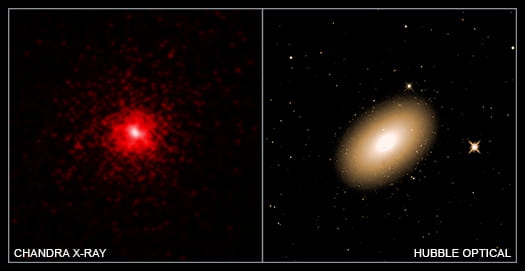Astronomers find atypically evolved galaxy with tightly packed dark matter at its core

Using data from NASA’s Chandra X-ray Observatory, UCI astronomers have identified a galaxy with an unexpectedly high amount of dark matter at its core. Descended from a family of galaxies called “red nuggets” that formed relatively soon after the Big Bang but were stalled in their growth about 10 billion years ago, Markarian 1216 has gone through an atypical evolution in terms of its stellar content and the invisible dark matter that, through gravity, holds the structure together.
To test whether the dark matter is as tightly packed as the stars usually are in of this type of elliptical galaxy, the UCI astronomers measured its heft by analyzing the X-ray brightness and temperature of hot gas at different distances from Mrk 1216’s center. “When we compared the Chandra data to our computer models, we found a much stronger concentration of dark matter was required than we find in other galaxies of similar total mass,” said David Buote, UCI professor of physics & astronomy and co-author of a recently released study in The Astrophysical Journal. “This tells us the history of Mrk 1216 is very different from the typical galaxy; essentially, all of its stars and dark matter were assembled long ago, with little added in the past 10 billion years.”
Buote and co-author Aaron Barth, also a UCI professor of physics & astronomy, write that a halo of dark matter formed around the center of Mrk 1216 about 3 or 4 billion years after the Big Bang. Elliptical galaxies of this type usually grow over time as they merge with smaller ones, but Mrk 1216 did not. “The old ages and dense concentration of the stars in compact elliptical galaxies like Mrk 1216 seen relatively nearby provided the first key evidence that they are the descendants of the red nuggets seen at great distances,” Barth said. “We think the compact size of the dark-matter halo seen here clinches the case.”